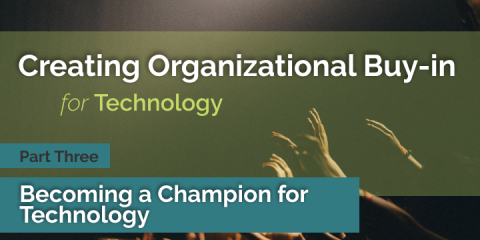Becoming a Champion for Technology

Being a part of an organization that utilizes all available resources to assist not only those you help support, but the staff and overall operations of the company sounds like a win win for all involved. But how is your organization able to get to that point? It could all start with YOU!
If you’ve missed the first two posts in the series, read up on creating organizational buy-in with The Basics, which covers the main steps to follow to help gain buy-in, and Breaking Barriers, which walks through common sticking points and offers solutions to get everyone on board.
The experts:
 |
Sean Henderson, Information Systems Analytics Manager Hammer Residences |
 |
Kathy Larson, Director of Brain Injury and Specialty Support Services REM Minnesota |
 |
Kit Piltingsrud, Program Manager and Assistive Technology Professional Living Well Disability Services |
Put Yourself out There
To become the go-to-tech-person in your organization, you have to first let people know what you’re trying to accomplish and why it’s important—for them and for the organization.
- Be everywhere. Literally. Attend all staff meetings, workshops, and team huddles to discuss the benefits of technology and share examples. Five minutes at the beginning of each meeting for a few months running is a great way to provide valuable information in a quick and digestible format to get individuals comfortable with the addition of technology in care plans.
- Create opportunities to get in front of people by thinking outside the box. You could host tech talks like Sean or even create tech experience nights. The main point is to utilize your resources and creativity to meet individuals where they are—both physically and by interest level.
Share the Technology
Seeing is believing. Putting technology support options and devices in front of people is key to getting them on board.
- Bring the technology to them. Demonstrations are a great way to show individuals what tech is available, and may also help get them comfortable with the idea of technology use by being able to see it (and test it out) themselves. Starting with lower tech/lower cost options is a great first step to get people comfortable with utilizing tech supports.
- Share success stories and resources to get the latest and greatest technology in front of them. Seeing what others are doing helps get people thinking about possible uses, and about other individuals that could benefit from like technology. Subscribing/forwarding on the TRC monthly newsletter is a great start to share success stories and technology news from around the web.
Continue Training
Training. Training. Training. If you’ve read through The Basics and Breaking Barriers, you may have noticed a theme. Without proper training and check-ins to ensure the technology is always meeting the current needs of the individual, technology implementations may stall out, and frustration levels may rise.
- Cultivate shared learning experiences and model behavior. Being present during implementations and having staff, individuals, and family members be a part of setting up the technology supports (no matter how simple) helps create a “learning together” atmosphere and gets everyone familiar with the technology and on the same page.
- Create training documents for the team and for future hires. Include notes about the initial implementation, why you chose the tech you chose, and any tweaks you made along the way to give new staff background and get them up to speed.
- Build on the momentum. Once people begin to realize the benefits of technology use, take the training a step further by spreading the word through experienced staff.
Ready to bring technology supports to your organization but have a few follow-up questions before you get started? Ask the Mentors! TRC Mentors are available to help answer any remaining questions you have and to help you get started. Learn more about the TRC Mentors.
Don’t miss the next article!
Visit the ARRM Technology Resource Center to learn about more success stories and case studies showing how technology is changing the lives of those living with disabilities or learn more about how to start the conversation.




